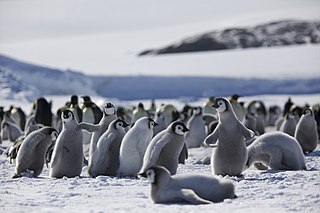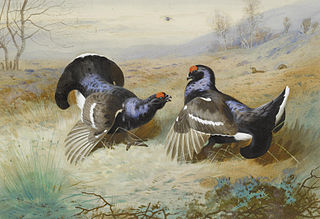
Within the field of social evolution, Hamiltonian spite is a term for spiteful behaviors occurring among conspecifics that have a cost for the actor and a negative impact upon the recipient.

Within the field of social evolution, Hamiltonian spite is a term for spiteful behaviors occurring among conspecifics that have a cost for the actor and a negative impact upon the recipient.
W. D. Hamilton published an influential paper on altruism in 1964 to explain why genetic kin tend to help each other. [1] He argued that genetically related individuals are likely to carry the copies of the same alleles; thus, helping kin may ensure that copies of the actors' alleles pass onto next generations of both the recipient and the actor.
While this became a widely accepted idea, it was less noted that Hamilton published a later paper that modified this view. [2] This paper argues that by measuring the genetic relatedness between any two (randomly chosen) individuals of a population several times, we can identify an average level of relatedness. Theoretical models predict that (1) it is adaptive for an individual to be altruistic to any other individuals that are more closely related to it than this average level, and also that (2) it is adaptive for an individual to be spiteful against any other individuals that are less closely related to it than this average level. The indirect adaptive benefits of such acts can surpass certain costs of the act (either helpful or harmful) itself. Hamilton mentioned birds and fishes exhibiting infanticide (more specifically: ovicide) as examples for such behaviors.
Briefly, an individual can increase the chance of its genetic alleles to be passed to the next generations either by helping those that are more closely related, or by harming those that are less closely related than relationship by chance. [3] [4]
Though altruism and spitefulness appear to be two sides of the same coin, the latter is less accepted among evolutionary biologists.
First, unlike the case with the beneficiary of an altruistic act, targets of aggression are likely to act in revenge: bites will provoke bites. Thus harming non-kin may be more costly than helping kin.
Second, presuming a panmictic population, the vast majority of pairs of individuals exhibit a roughly average level of relatedness. For a given individual, the majority of others are not worth helping or harming. While it is easy to identify the few most closely related ones (see: kin recognition), it is hard to identify the most genetically distant ones.
Most terrestrial vertebrates exhibit a certain degree of site fidelity, so levels of kinship tend to correlate negatively with spatial distance. While this may provide some cues to identify the least related individuals, it may also ensure that non-kin rarely if ever meet each other.
Many animal species exhibit infanticide, i.e. adults tend to kill the eggs or the offspring of conspecifics, even if they do not feed on them (in the absence of cannibalism). [5] This form of spitefulness is relatively free from the threat of revenge – provided that the parents and relatives of the target are either weak or far away. Infanticide may not be a form of spite as in many cases the loss of offspring to the female brings it back into estrous providing a mating advantage to an infanticidal male. This is seen in lions. [6]

An individual carrying a long-lasting infection of virulent pathogens may benefit from (1) channelling the flow of pathogens from its own body away from its kin and (2) directing them toward non-kin conspecifics. The adaptive nature of this behavior has been supported by the analysis of theoretical models [7] [8] and also by the analyses of the behavioral repertoire of different animal species. [9] Thus, tuberculosis-infected European badgers and rabies-infected dogs equally tend to emigrate from their natal ranges before starting to distribute the pathogens. Similarly, wild herds of Asian elephants tend to defecate into drinkwater holes apparently to keep rival herds away. [10]

Throughout human history, war often emerges as a costly form of aggression typically targeting the non-kin enemy. Naturally, most wars appear to be motivated by potential benefits other than the genetic. Nevertheless, widespread infanticide during periods of war indicates Hamiltonian elements as well. Infanticide is a biologically spiteful action in that it costs the killer time and energy, and opens the killer to the threat of revenge, without any direct compensating benefits[ citation needed ].

Altruism is the principle and practice of concern for the well-being and/or happiness of other humans or animals. While objects of altruistic concern vary, it is an important moral value in many cultures and religions. It may be considered a synonym of selflessness, the opposite of selfishness.
Sociobiology is a field of biology that aims to examine and explain social behavior in terms of evolution. It draws from disciplines including psychology, ethology, anthropology, evolution, zoology, archaeology, and population genetics. Within the study of human societies, sociobiology is closely allied to evolutionary anthropology, human behavioral ecology, evolutionary psychology, and sociology.

Kin selection is a process whereby natural selection favours a trait due to its positive effects on the reproductive success of an organism's relatives, even when at a cost to the organism's own survival and reproduction. Kin selection can lead to the evolution of altruistic behaviour. Kin selection is related to the concept of inclusive fitness, which combines the number of offspring produced with the number an individual can ensure the production of by supporting others. A broader definition of kin selection includes selection acting on interactions between individuals who share a gene of interest even if the gene is not shared due to common ancestry.

Behavioral ecology, also spelled behavioural ecology, is the study of the evolutionary basis for animal behavior due to ecological pressures. Behavioral ecology emerged from ethology after Niko Tinbergen outlined four questions to address when studying animal behaviors: What are the proximate causes, ontogeny, survival value, and phylogeny of a behavior?

Group selection is a proposed mechanism of evolution in which natural selection acts at the level of the group, instead of at the level of the individual or gene.
In evolutionary biology, inclusive fitness is one of two metrics of evolutionary success as defined by W. D. Hamilton in 1964:

In 1938, the Austrian ethologist Karl von Frisch made his first report on the existence of the chemical alarm signal known as Schreckstoff in minnows. An alarm signal is a response produced by an individual, the "sender", reacting to a hazard that warns other animals, the receivers, of danger. This chemical alarm signal is released only when the sender incurs mechanical damage, such as when it has been caught by a predator, and is detected by the olfactory system. When this signal reaches the receivers, they perceive a greater predation risk and exhibit an antipredator response. Since populations of fish exhibiting this trait survive more successfully, the trait is maintained via natural selection. While the evolution of this signal was once a topic of great debate, recent evidence suggests schreckstoff evolved as a defense against environmental stressors such as pathogens, parasites, and UVB radiation and that it was later co-opted by predators and prey as a chemical signal.
The gene-centered view of evolution, gene's eye view, gene selection theory, or selfish gene theory holds that adaptive evolution occurs through the differential survival of competing genes, increasing the allele frequency of those alleles whose phenotypic trait effects successfully promote their own propagation. The proponents of this viewpoint argue that, since heritable information is passed from generation to generation almost exclusively by DNA, natural selection and evolution are best considered from the perspective of genes.
In biology, altruism refers to behaviour by an individual that increases the fitness of another individual while decreasing the fitness of themselves. Altruism in this sense is different from the philosophical concept of altruism, in which an action would only be called "altruistic" if it was done with the conscious intention of helping another. In the behavioural sense, there is no such requirement. As such, it is not evaluated in moral terms—it is the consequences of an action for reproductive fitness that determine whether the action is considered altruistic, not the intentions, if any, with which the action is performed.
In fair division problems, spite is a phenomenon that occurs when a player's value of an allocation decreases when one or more other players' valuation increases. Thus, other things being equal, a player exhibiting spite will prefer an allocation in which other players receive less than more.
The green-beard effect is a thought experiment used in evolutionary biology to explain selective altruism among individuals of a species.
Kin recognition, also called kin detection, is an organism's ability to distinguish between close genetic kin and non-kin. In evolutionary biology and psychology, such an ability is presumed to have evolved for inbreeding avoidance, though animals do not typically avoid inbreeding.
Allomothering, allomaternal infant care/handling, or non-maternal infant care/handling is performed by any group member other than the mother. Alloparental care is provided by group members other than the genetic father or the mother and thus is distinguished from parental care. Both are widespread phenomena among social insects, birds and mammals.
Competitive altruism is a possible mechanism for the persistence of cooperative behaviors, specifically those that are performed unconditionally. The theory of reciprocal altruism can be used to explain behaviors that are performed by a donor who receives some sort of benefit in the future. When no such compensation is received, however, reciprocity fails to explain altruistic behavior.

Helping behavior refers to voluntary actions intended to help others, with reward regarded or disregarded. It is a type of prosocial behavior.
Microorganisms engage in a wide variety of social interactions, including cooperation. A cooperative behavior is one that benefits an individual other than the one performing the behavior. This article outlines the various forms of cooperative interactions seen in microbial systems, as well as the benefits that might have driven the evolution of these complex behaviors.
Darwinian anthropology describes an approach to anthropological analysis which employs various theories from Darwinian evolutionary biology. Whilst there are a number of areas of research that can come under this broad description some specific research projects have been closely associated with the label. A prominent example is the project that developed in the mid 1970s with the goal of applying sociobiological perspectives to explain patterns of human social relationships, particularly kinship patterns across human cultures.
Inclusive fitness in humans is the application of inclusive fitness theory to human social behaviour, relationships and cooperation.
Evolutionary biologists have developed various theoretical models to explain the evolution of food-sharing behavior—"[d]efined as the unresisted transfer of food" from one food-motivated individual to another—among humans and other animals.
Reciprocal altruism in humans refers to an individual behavior that gives benefit conditionally upon receiving a returned benefit, which draws on the economic concept – ″gains in trade″. Human reciprocal altruism would include the following behaviors : helping patients, the wounded, and the others when they are in crisis; sharing food, implement, knowledge.